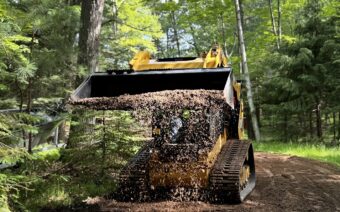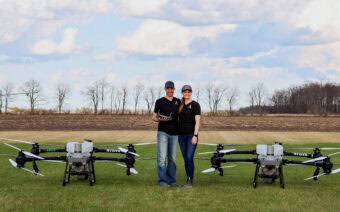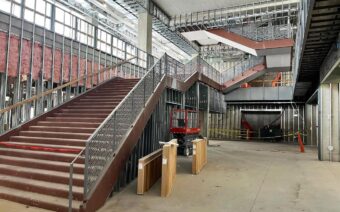
April 1, 2024
AMHERST JUNCTION – When Tom and Brenda Trzinski purchased a former guernsey farm in Amherst Junction in 1999, the couple said they had a different species in mind for the farm than cows – alpacas.
“When we started a family, (we wanted) to have a gentle animal, an animal that you didn’t need to kill for profit and something that I could (tend to) and that could provide an income while I was home with the kids,” Brenda said. “They could grow up living on a farm, learn how to work on a farm and learn all of the good responsibilities that come with being raised on a farm.”
She would know – Brenda said she grew up a farm girl herself near West Bend, where her family grew cash crops and raised a few animals.
The Trzinskis’ dream of raising their children on a farm with a balance of farm work ethic, fun and education came true when they established Rustic Ridge Alpacas in 2001 – an endeavor that is still going strong today.
“He was ready to dive right in and learn what we needed to know,” Brenda said of her husband.
As the farm grew, so too did the Trzinskis – now a family of six (which now includes kiddos Anna, Eli, Sarah and Elizabeth).
Rustic Ridge
Rustic Ridge Alpacas sits in the middle of 80 acres of greenery, nestled between the Poncho Creek and the Tomorrow River, in an area called the Tomorrow Valley.
The terrain was carved out by glacier activity thousands of years ago, and within walking distance from the farm, Brenda said, is a creek that runs through some Department of Natural Resources land.
The Trzinskis said the Rustic Ridge name was inspired by the 100-plus farm it sits on – because it sits on top of a ridge and not many things on the property are new.
“If you know anything about old farm buildings and old buildings, you know that nothing is new or fancy,” Brenda said. “Rustic fits the description.”
A bit more about alpacas
Though often confused with llamas, Anna, 21, – the eldest of the Trzinski kids – said alpacas are smaller, with rounder bodies, shorter noses and tails that they hold close to their bodies, rather than extending them.
“Alpacas and llamas are cousins, so they are related, but the main difference is that alpacas are a little bit shorter, and usually more on the calmer side,” she said. “Whereas llamas tend to spit more and be a little bit more aggressive.”
Alpacas and llamas, Anna said, are part of the camelid family, which also includes camels.
Alpacas measure about 35 inches high from the shoulder and range from 47-85 inches long and weigh in at 100-175 pounds.
According to the Alpaca Owners Association, alpacas vary in color from black, brown, gray, tan, light yellow and white, with at least 16 variations on the spectrum.
An alpaca can produce five to 10 pounds of fleece in a year, depending on the size of the animal.
“The fiber is a really good insulator, and it’s not as itchy as sheep wool, which makes it really warm and comfortable,” Anna said.
She said alpaca wool is finer than the wool of a llama, making it softer and less scratchy than llama wool or even merino (a breed of sheep) wool.
The alpacas eat grain pellets, minerals and grass hay or pasture grass.
The 80-acre setting of Rustic Ridge, Brenda said, means the alpacas have plenty of space to graze in, even when rotating pastures.
According to the Alpaca Owners Association, for every 125 pounds of body weight, an alpaca will eat about two pounds of grass hay or pasture grass.
In summertime, Brenda said the alpacas get to eat grass in the pastures.
And this season, she said, the animals got to dine al fresco in the fields up until Christmastime, due to a lack of snow cover.
Perfect fit
The calm, easygoing nature of alpacas, Brenda said, made them ideal animals for her family’s farm.
“They were gentle enough that I could put the kids on a sleeping bag or a blanket in the pasture, and I could be a mom and a farmer all at the same time,” she said. “So, the kids literally grew up right with them.”
As the Trzinski children grew, so too did their responsibilities on the farm – helping in all aspects of farm life – which, based on age, included feeding, watering, poop patrol, med distribution and fence building.
Even now as some of them embark on the next journeys in life, they still help out when and where needed.
Anna – who is currently attending the University of Wisconsin-Stevens Point (UWSP) where she is pursuing a degree in business administration – said she helps her mother with the administrative end of Rustic Ridge.
Annual haircuts
Once a year, Anna said, a professional shearer pays a visit to Rustic Ridge to shear the herd. She said it’s usually around the end of April or beginning of May, depending on weather conditions.
“We get them all done in a couple hours, so it’s pretty quick,” she said. “That way, they are nice and cool for the summer.”
The fur on the alpaca’s neck, shoulders, torso and back section, Anna said, is what’s known as the blanket.
“That’s what is mostly used, especially for the big things like sweaters and that kind of thing,” she said.
Alpaca hair, Anna said, has a hollow core, so it is filled with air, which adds warmth without weight.
After the shearing, the Trzinskis pick through every hair to remove any accumulated debris that may have gotten lodged in the alpacas’ coats over the past 12 months.
To help the process, Tom said his dad built them a skirting table, which is covered with chicken wire and essentially works like a sieve.
“What you will do is kind of run your hands across it and sift it down so that any dirt falls through (the chicken wire), along with any burdock, pieces of hay, thistle or weeds of some sort, as well as dung or poop pellets,” Anna said.
Once it’s free of debris, she said the fiber is bagged up and sent off to a company that spins it into yarn.
Some alpaca farmers, Anna said, choose to have the fleece spun into yarn and returned to them so they can make their own items.
Others opt to exchange the wool for a discount on the alpaca items already made, which is the route she said Rustic Ridge chooses to go.
“We buy the finished product at a reduced price,” she said. “Then we have a couple places where we sell the finished products, mostly the socks, but we also have hats, gloves, alpaca teddy bears and things like that.”
Anna said Rustic Ridge’s alpaca items are available at four shops in the area, as well as have a few items listed on the farm’s website (rusticridgealpacas.com).
Socks, Brenda said, are a high demand item, as are the felted insoles for shoes – which provide cushion and an extra layer of warmth, as well as absorbs and wicks away moisture.
“If you are out ice fishing or hunting or something and you get a little bit of water in your boot, it will soak it up,” she said.
Unlike sheep’s wool, Anna said alpaca fleece is smooth and less likely to feel itchy to the wearer.
“Alpaca fiber is stronger and lighter,” she said. “It’s warmer and more resilient than wool from sheep.”
Anna said it’s often likened to cashmere in that it’s soft, not scratchy and very warm.
“It doesn’t have that itch factor or prickle, and it doesn’t irritate you like a lot of people are irritated with sheep wool,” she said.
Furthermore, Anna said, Alpaca fiber doesn’t contain any lanolin like sheep’s wool does, so it’s ready to spin after a brief cleaning of the fleece.
“At the surface, you might feel maybe some hay or a little bit of dirt but if you part the fiber and open it down to the inside, it’s just super soft,” she said. “I don’t even know how to describe it, because I always describe everything like an alpaca.”
‘Manageable’
Brenda said right now she has 22 alpacas, the lowest number at Rustic Ridge in years – at one point, she said the farm was home to 50 alpacas.
Part of this, she said, is due to the Trzinski children leaving the farm to pursue their own aspirations – which in turn puts more of the chore load onto Tom and Brenda.
“We’re at a good, manageable number (of alpacas) right now,” she said.
Both Tom and Brenda also work full-time off the farm – she runs a massage studio in Stevens Point called Natural Expressions, and he works as a land surveyor.
Though Anna lives at home for the time being while attending UWSP, the second oldest, Eli, is in the army and is currently stationed in Alaska.
Third oldest, Sarah, is headed to Ripon College next fall.
So, Brenda said thankfully alpacas aren’t much work – noting that whoever happens to be available will do the feeding and watering.
“Really, all we do is feed them when we get out of school, give them grain… and a couple buckets of water for them to drink,” Anna said. “If we did the chores by ourselves, it would take about 45 minutes. It doesn’t require too much work.”
Brenda said alpacas are “probably the easiest animals” to take care of.
“They are so low maintenance, and that was a big reason why we decided to get into them,” she said. “We could still raise our kids on the farm, but have the flexibility, unlike with a dairy farm where you are locked into certain times, and there are really time constraints. As long as they have water out there and a food source, you can feed them anytime of day.”
A few years ago, in an effort to streamline yard duties, Brenda said they got some goats – which were supposed to eat the weeds in the pastures that the alpacas don’t eat.
Anna said that, however, didn’t exactly go as planned.
“They (the goats) didn’t really eat the weeds,” she said. “They just ate the same kind of stuff as the alpacas.”
“So, now they’re just pets,” she said.
A part of the community
The farm and its animals are well known in the community – often marching the animals in parades, participating in cameos in school plays, interacting at the county fair and being part of 4-H presentations and other programs.
Brenda said the animals have also played their part as therapy animals to those who need a hug or someone to talk to, and have participated in programs for those with special needs.
 Inthewoods Sugar Bush gets ‘sappy’ with maple syrup
Inthewoods Sugar Bush gets ‘sappy’ with maple syrup Feeding customers in a relaxed setting for 90 years
Feeding customers in a relaxed setting for 90 years






